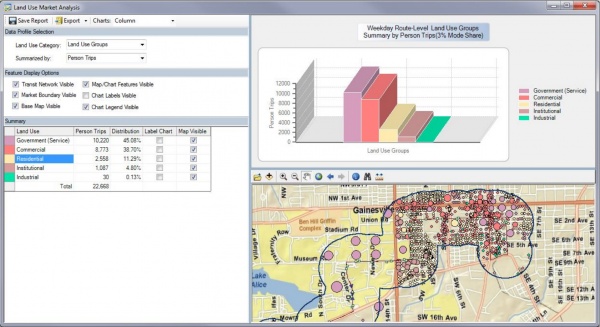Transit Boardings Estimation and Simulation Tool (TBEST)
| Vendor | FDOT |
|---|---|
| License | unknown |
| Documentation | http://tbest.org/downloads/?dl_cat=10 |
| Data Input | ACS/Census, OpenStreetMap, InfoUSA, custom shapefiles, GTFS |
| Data Output | GTFS, GIS shapefiles, maps, ridership estimates, accessibility statistics |
| Website | http://tbest.org/ |
Transit Boardings Estimation and Simulation Tool (TBEST) is a GIS-based transit modeling and analysis program developed for the Florida Department of Transportation. It was originally meant to estimate ridership numbers for Florida transit agencies for transportation demand management plans, but has been expanded to be applicable across the country and to assist in processes such as market analysis, bus rapid transit modeling, and Title VI and accessibility analysis. TBEST requires a licensed copy of ArcGIS and Windows 7 or later, but the software itself is free to use.
How it Works

TBEST is based on transit system data. While these templates are provided for Florida agencies, in the rest of the country they must be created manually. This has been done in Los Angeles[1]. The TBEST team is available to help configure local GTFS and other data to be inputted into the system. Once the base scenario has been imported, actual ridership data is used to validate the scenario.
After validating the base scenario, TBEST can be used for in-depth scenario planning. A user can create alternative scenarios with new routes, stops, or service levels. These new scenarios can then be compared to the base scenario. These analyses can be done for six different time periods: AM peak, off-peak, PM peak, night, Saturday, and Sunday.
Market Analysis
The viability of a transit line is determined in part by the area it serves. To forecast viability, TBEST allows users to perform market analyses on current or potential routes. This can be done either using socio-economic data from the census or parcel-level land use data. The analysis can also take into account projected population, household, or employment growth.
Using socio-economic data, the analysis can be broken down to population, household, income, and employment profiles. Users can also see the distribution of a wide range of individual market variables, including race, gender, age, income, and vehicle ownership. These variables can then be compared to system averages. With land use data, the market area can be broken down by use.
After a market analysis has been performed, TBEST can generate reports in formats such as PDF, Excel, and PowerPoint.
Title VI Analysis
All transit agencies are required to comply with Title VI of the 1964 Civil Rights Act, which prevents recipients of federal money from discriminating against protected classes[2]. This means performing analyses to ensure that service changes are not having disparate impacts on minority populations. TBEST includes a toolset to help automate this process. After inputting Title VI-compliant socio-economic data, the GTFS network, stop amenities, and service area, the software will perform an analysis and output the results in report and map format, as mandated by Title VI. Maps are created in the ArcMap format to facilitate further editing, if necessary. The core purpose of TBEST is scenario planning, and the program makes it easy to compare Title VI analyses for various potential scenarios. TBEST contains tools for performing both system-wide triennial analyses and interim disparate impact analyses on specific changes.
Transit Access
TBEST offers two different toolsets measuring transit access: Access to Transit and Access via Transit. Access to Transit measures walk access from homes and jobs to transit, while Access via Transit measures jobs, people, and land use accessible between stop pairs. Like the Title VI analysis, these analyses can be performed automatically after a few variables have been inputted and can be used to compare various scenarios.
References
Additional Reading
- This extremely detailed guide provides illustrated instructions for all of TBEST's many features.
TBEST - Guidelines for Transit Development Plan Ridership Estimation Review and Reporting
- This document outlines the way in which TBEST can be used in transportation development plan modeling.
Utilizing TBEST for Comprehensive Transit Planning - CUTR Webcast Recording - March 2, 2017
- Recording of an hour-long webinar presented by Rodney Bunner covering the functionality of the Transit Boardings and Simulation Tool (TBEST). Hosted by the Center for Urban Transportation Research (CURT).
